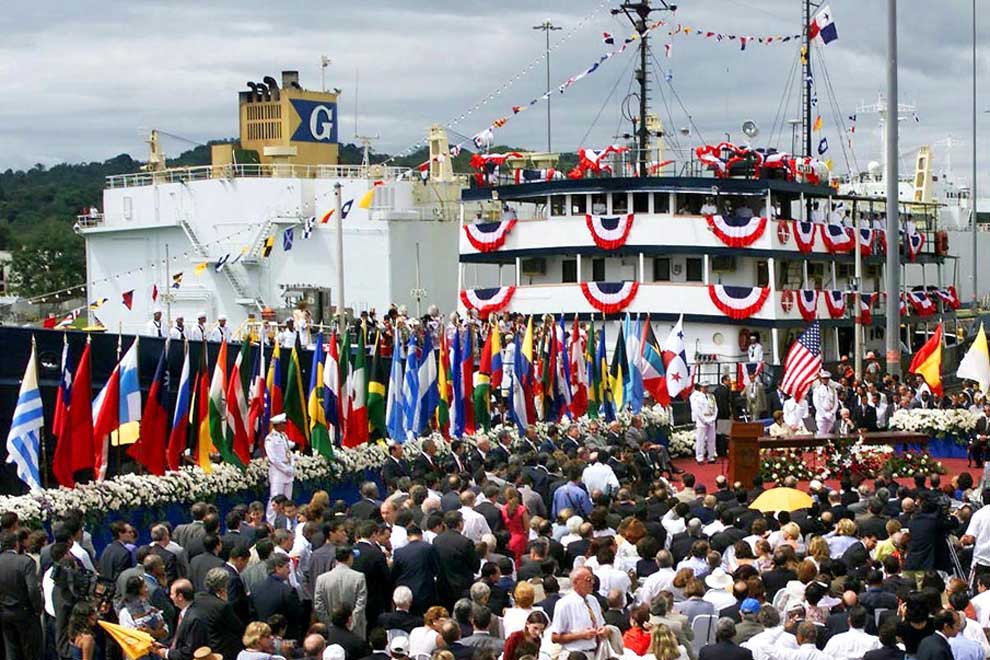
A file photo taken on December 14, 1999 shows a general view of the official handover ceremony of the Panama Canal from the US to Panama at the Miraflores locks. AFP
Panama on Tuesday marks two decades of control over the vital interoceanic Canal following its return by the US, but worries over weak traffic and climate change loom.
On December 31, 1999, at midday sharp, then-president Mireya Moscoso hoisted Panama’s red, blue and white flag over the Canal administration building for the first time.
The entire Central American nation was swept with joy, having finally received sovereignty over the Canal after 85 years of management by the US, which built and inaugurated the ocean route in August 1914.
Twenty years later, recurrent droughts caused by climate change are the main threat to the 80km-long canal between the Atlantic and Pacific oceans, through which most American, Chinese and Japanese merchant ships pass.
“The impact of climate change is quite evident on the Panama Canal,” warned its administrator Ricaurte Vasquez.
A historic deficit of rainfall has lowered the water level in the lakes which supply the Canal and the “challenge is now to find the solution to this lack of water for the next 50 years,” he explained.
According to the Panama Canal Authority (ACP), the rainfall deficit reached 27 per cent in 2019 compared to the average.
In addition, the temperature of Gatun Lake, the main tributary of the Canal, has increased by 1.5C over the past ten years, which causes significant loss of water by evaporation.
That has meant the Canal only had three billion cubic meters of water this year, instead of the 5.2 billion cubic meters needed for its normal operation.
“Climate change is already hitting us. For me, this is the main threat hanging over the Canal,” former administrator Jorge Quijano said.
To remedy the situation, Panama is studying the possibility of finding other freshwater resources for the Canal, such as pumping or desalinating seawater or even building reservoirs.
But these are costly and complicated solutions that could cut into the Canal’s contributions to Panama’s finances – nearly $1.8 billion last year.
Meanwhile, Canal authorities fear shipowners will prefer other sea routes that avoid the Central American isthmus, such as the Suez Canal, which, according to the ACP, has lowered its rights of passage by 60 per cent.
In addition, global warming, by melting the polar ice, could open “especially in the north, new competitive maritime routes,” Felipe Chapman, associate director of the economic consultancy Indesa, said.
The Canal was widened in 2016 and is used mainly to link Asia to the east coast of the United States, but is also suffering from a decrease in commercial traffic as the global economy slows.
This danger is obviously “out of Panama’s control, and stems from the consolidation of the Asian economies, especially China,” Horacio Estribi, an advisor to the Panamanian economy minister, said.
Until recently, a little less than five per cent of world trade transited through Panama, but this figure has fallen to 3.5 per cent, according to the Canal’s administrator.
The Canal nevertheless did record business in fiscal 2019 with about $3.37 billion generated from tolls, services and the sale of electricity from its dams, along with 450.7 million tons of goods passing through.
But the center of gravity of world trade traffic has shifted to Asia and Europe, according to the Canal Authority.
“You have to see how the standoff over trade between the United States and China ends,” said Quijano, who further warned, “As production moves further west from Asia, the route through Panama becomes less attractive.”











